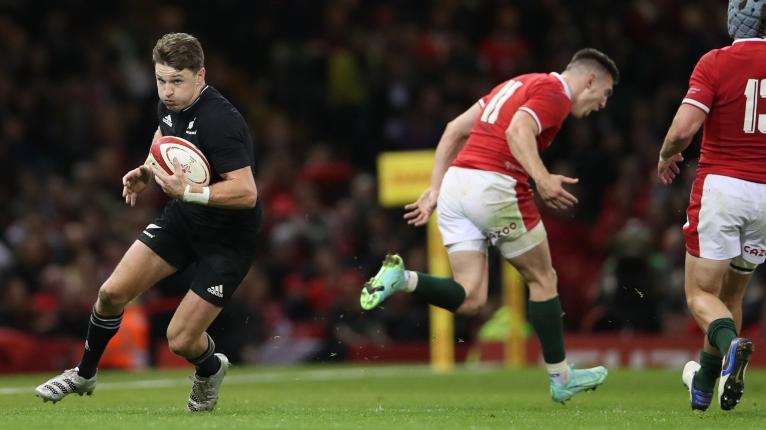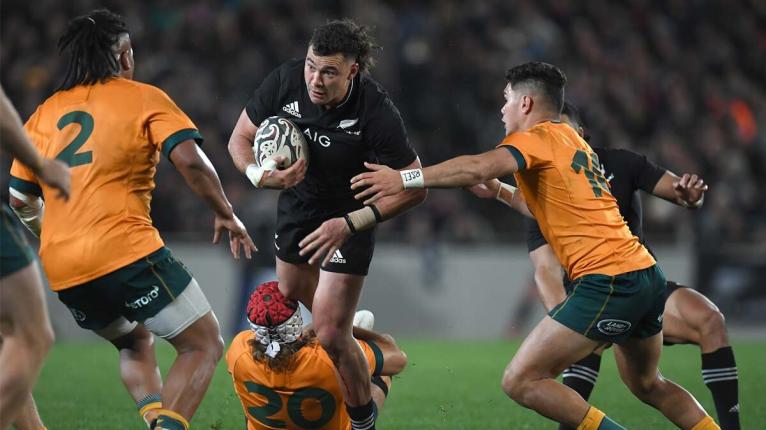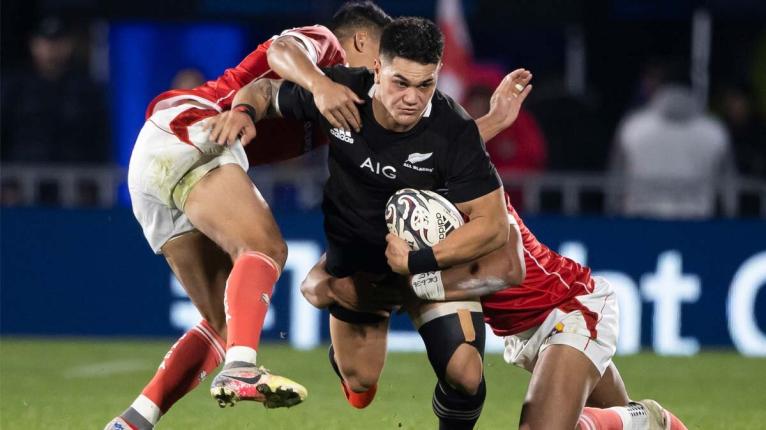There are few teams in world rugby that could face off with another tier-one side, end the match with a completely different backline to the one that started game, and set a record-winning margin in the process.
But that’s exactly what the All Blacks did in Cardiff over the weekend.
The 54-16 victory at the Principality Stadium marked New Zealand’s biggest victory over Wales at their home ground, equalling the points differential recorded in 2005 when, between the first game of the tour against Wales and the second against Ireland, Graham Henry was able to completely rotate his side and still score two comprehensive victories.
It’s likely that a similar number of changes will be utilised by Ian Foster between this match and the next against Italy, but the more impressive feat is the rotation that occurred on the park at the Principality Stadium on Saturday evening.
The All Blacks kicked off the affair with a backline of TJ Perenara, Beauden Barrett, Rieko Ioane, David Havili, Anton Lienert-Brown, Will Jordan and Jordie Barrett.

Come the end of the match, however, not one of those players was still on the field and playing in the same position.
The introductions of Brad Weber, Richie Mo’unga and David Havili saw Perenara, Havili and Jordan leave the field while the four players that remained were shifted into new positions. New centurion Beauden Barrett dropped from first five to fullback, with his younger brother shifting to the right wing. Reece’s introduction on the left, meanwhile, forced Ioane into the midfield and Lienert-Brown from centre to second five-eighth.
While we’ve seen the All Blacks utilise similar tactics throughout the year, it’s the first time we’ve seen a complete shake-up of the backline during a game and is a testament to the adaptability and wide-ranging skillsets of the players currently called upon by Ian Foster.
It was also not something that happened simply by chance.
“They train there,” Foster said following the match. “The one thing I’d say is it’s not a fluke or something that we go in unplanned about.
“I said before the game that we wanted to try something different with our bench by bringing Sevu in, having a specialist winger. We were quite keen to see what sort of energy he could bring with his footwork and his attitude and I think we saw that.
“The fact that Anton can play either position [is a bonus]; Rieko was strong moving in and probably looked a little bit more settled at centre this week than wing, so we’ve got some nice little issues going there … At the end, I really wanted to keep Jordie on to finish the game with his brother, I thought that would be quite special, so there was a little bit of juggling at the back.”
Although the final margin of victory was significant, it took the All Blacks backs some time to really find their groove in the match.
Beauden Barrett may have snatched a Gareth Anscombe pass out of the air within the opening five minutes of the match and dashed away to score the first try of the game, but it took another half hour for the second to come – and although Perenara was the man awarded the try, it was through some repeated carries and good interplay from the forwards that the opportunity presented itself.
Throughout the bulk of the game, the kick-off point of most backline attacks seemed to entail inside centre David Havili crashing the ball up in the midfield – a task bestowed on him throughout the season which has yet to really bear fruit.

On more than one occasion, the 90kg Havili was either shunted backwards or lost possession completely and the forwards had to be called upon to claw back the ascendancy and momentum.
It’s a tactic that simply doesn’t suit Havili’s capabilities. Although the utility back has packed on a couple of pounds this year to increase his physicality in the centres, he’s still one of the smallest battering rams you’ll find in world rugby.
Havili, by most measures, is one of the most adaptable and skilful players in the game. He can kick, he can pass, he can run – but he’s not a wrecking ball, and likely never will be. His ability to play across the backline is a useful attribute but given the flexibility that Foster already has amongst the options available, perhaps the All Blacks need to run with a physical presence in the midfield, if that’s the game plan they want to persist with.
With the likes of the Barrett brothers, Rieko Ioane, Anton Lienert-Brown and Damian McKenzie on deck, Foster is in a position where he can afford to select a couple of specialists in his backline.
That specialist could be Quinn Tupaea.
Tupaea was perhaps the most shocking selection in the All Blacks at the beginning of the year – not because he isn’t a talented up-and-coming midfielder, but because he’d spent a significant portion of the season on the sidelines through injury and he had only really started to string together strong performances for the Chiefs this year.
That could be attributed to the fact that in his debut year with the Chiefs last season, he was used primarily at outside centre, with Anton Lienert-Brown inside him, and struggled at times with the extra defensive duties of that role.
This year, the roles were reversed and Tupaea was used exclusively in the No 12 jersey, and both he and Lienert-Brown looked more at home with the change.
“I think 12 suits my game a bit better,” Tupaea told Stuff in April. “And Anton is happy to slot in wherever he can I guess. He’s sort of letting me play where I want to play so he’s a good guy.
“Second five, you probably get your hands on the ball a bit more, being a bit in closer to it. Centre, it’s a bit harder to defend, second five you get more front-on tackles, you’re not really looking at back doors and stuff, so it’s sort of easier to play there.”

Tupaea, at close to 100kg, has a fair bit more heft to him than Havili and while he doesn’t have as well-rounded a game, he does possess all the attributes needed to have a physical impact in the midfield.
With the Barretts in the backline, Havili’s kicking game is more of a bonus than a need. Against the more physical sides, however, the All Blacks are going to need someone in the midfield who can cart the ball and regularly get the team over the gain-line.
Samu Kerevi’s addition to the Wallabies was a huge boon for the side and his impetus in the midfield helped create a solid platform for the backs from which they could conduct their more elaborate plays.
Tupaea is not on the same level as Kerevi, but at just 22 years of age, there’s plenty of time for him to develop his all-around game.
He’ll likely be given a shot against Italy next weekend but that match looms simply as a chance for the selectors to give their second-stringers a run. Providing that Tupaea can perform as well against the Azurri as he has throughout the rest of the season, Foster and co will likely have enough evidence to make a big change to the starting line-up for the final two games of the year, against Ireland and France.
David Havili is a supremely talented player who could be asked to slot in anywhere across the backline and could do a serviceable job. He’s not the only player in the side with those qualities, however, and given the versatility the All Blacks do have access to, maybe now is the time to call upon a specialist inside centre.


Like your analysis again Tom and agree that Quinn would be a good plant at twelve for remainder of 2021 considering his tender age if ALB outside or Dmac behind him against Italy. I also feel sorry for Davo too SP and Caleb as a midfield alternative at Blues...Baz would school him as RTS might be behind. LOL
The sad thing is that Razor won't be in charge before 2024 unless Foster abdicates or shoots himself in the foot! 🙃
Havili will never be a 12. Would like to see Blues groom Caleb Clarke at 12. Hes the sort of battering ram we need. In meantime Tupaea or ALB with Rieko at 13